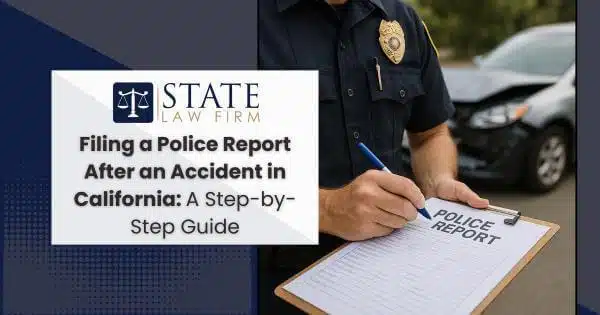A car accident can leave you overwhelmed in a matter of seconds. Whether it’s a fender-bender or something more serious, knowing what steps to take afterward can make a significant difference in how smoothly your recovery—both physical and financial—goes. One of the most essential actions you can take? Filing a police report.
In California, a police report isn’t just helpful—it can be crucial. It serves as an objective account of the incident, often forming the backbone of your insurance claim and any future legal action. In fact, according to the California Office of Traffic Safety, over 216,366 people were injured in motor vehicle crashes across the state in 2023 alone.
With numbers like that, it’s essential to be prepared. At State Law Firm’s Sherman Oaks office, our attorneys regularly help clients navigate what comes next after a collision, especially when the insurance company tries to challenge your side of the story. That’s why we emphasize the importance of documentation, starting with your police report.
This article walks you through the step-by-step process of filing a police report after an accident in California, offering practical advice and legal insights to help protect your rights. It pairs well with our companion guide on how to obtain your California accident report. It reflects our goal of empowering clients to take informed action, even before they call us.
Let’s get into it.
Understanding the Importance of Filing a Police Report
After a crash, emotions run high and adrenaline takes over—but filing a police report remains one of the most powerful tools at your disposal. It documents your version of events while they’re still fresh, establishes an official record for insurance purposes, and can help determine liability early on.
Here’s why it matters:
- Establishes key facts: A police report captures details that may fade from memory, such as road conditions, time, weather, and initial witness statements.
- Creates legal documentation: If your case ends up in court, a police report can serve as compelling evidence.
- Strengthens your insurance claim: Insurance adjusters often rely heavily on these reports to validate or dispute claims.
- Helps identify fault: When a fault is contested, a report from law enforcement can help clarify responsibility based on physical evidence and objective observation.
If you’re unsure about how to get your report after the fact, we’ve outlined the process in detail in our complete guide here.
When is it Necessary to file a Police Report in California?
California law doesn’t always require a police report, but in many situations, it’s not optional. According to California Vehicle Code § 20008, drivers involved in an accident that results in injury or death must report the incident to law enforcement within 24 hours.
You should also file a report if:
- There’s an injury or fatality, no matter how minor it may seem.
- Property damage exceeds $1,000 (you’ll also need to submit a Form SR-1 to the DMV).
- It’s a hit-and-run—these should always be reported to help initiate an investigation.
- The other driver is uninsured or uncooperative, and you may need help protecting your rights.
Pro Tip: Even if you think your accident is minor, file the report. Injuries sometimes surface days later, and having a record in place can save you time and headaches.
Step 1: Ensuring Safety and Securing the Accident Scene
Before thinking about paperwork, your immediate priority is safety.
- Check for injuries to yourself and others.
- Move vehicles to a safe location if possible, especially if they are blocking traffic.
- Turn on hazard lights and set up cones or warning triangles if available.
- Call 911 to report the accident and request medical assistance, if needed.
- Avoid discussing fault at the scene—let the facts speak through the police report.
This initial step sets the foundation for everything else that follows. Prioritizing safety also demonstrates that you acted responsibly—something that can help your case later on.
Step 2: Gathering Information at the Scene of the Accident
While waiting for law enforcement, collect as much evidence as possible. It’s often the small details that become game changers later.
What to gather:
- Full names and contact info of all drivers and passengers
- Insurance and driver’s license information
- License plate numbers and vehicle make/models
- Witness names and contact details
- Photos of all vehicle damage, road signs, skid marks, and the wider scene
- Notes on weather, time, location, and anything unusual
Pro Tip: Use your phone to record voice memos or videos describing what happened while it’s still fresh in your mind.
Step 3: Contacting Law Enforcement to File Your Report
In some cases, law enforcement will already be en route. But if no one has called 911, and the incident qualifies under California’s reporting rules, you must notify the local police, sheriff, or California Highway Patrol.
Once they arrive:
- Be calm, clear, and factual.
- Don’t speculate—stick to what you saw, heard, or experienced.
- Ask for the responding officer’s name and badge number.
- Get the police report number (or incident ID) so you can follow up later.
Law enforcement will typically create a Traffic Collision Report at the scene or shortly after. This document becomes a vital part of your case, especially if liability is in dispute.
Step 4: Obtaining a Copy of Your Police Report
Once filed, your police report becomes an official document—but it doesn’t automatically arrive in your mailbox. You’ll need to request it from the appropriate agency, usually the local police department or CHP office.
Visit our comprehensive guide on how to obtain your California accident report for a breakdown of:
- Which agency to contact based on where the accident happened
- Online and in-person request options
- Processing timelines (often 5–15 business days)
- Costs and ID requirements
- What to do if the report contains errors or missing information
If you’ve never requested one before, don’t worry—we help our clients navigate this process every day.
Navigating Insurance Claims with Your Police Report in Hand
Once you’ve secured your report, it becomes one of your best allies in the insurance claim process. It’s often the first thing an adjuster will ask for—and the most evident proof of what happened.
Your report can help:
- Validate your version of events
- Confirm the other driver’s identity and policy information.
- Back up medical claims with time-stamped evidence
- Dispute false claims from the other party
Having a complete, properly documented report can prevent delays, reduce disputes, and ensure your damages are taken seriously. If your insurance company is pushing back or downplaying your injuries, don’t go it alone—our team at State Law Firm’s Sherman Oaks office knows how to fight back.
Protect Yourself by Filing a Police Report After an Accident in California Today
Filing a police report isn’t just about bureaucracy—it’s about protecting yourself, securing evidence, and making sure your story is heard. Whether your accident was minor or severe, don’t skip this critical step.
At State Law Firm, we’re here to walk you through every part of the process—from navigating accident reports to fighting for maximum compensation. When the system feels stacked against you, having a team of strategic, young litigators on your side makes all the difference.
If you’re unsure about what to do next after your crash—or you need help accessing or understanding your accident report—reach out to us. Let’s protect your rights and start building your case the right way.


